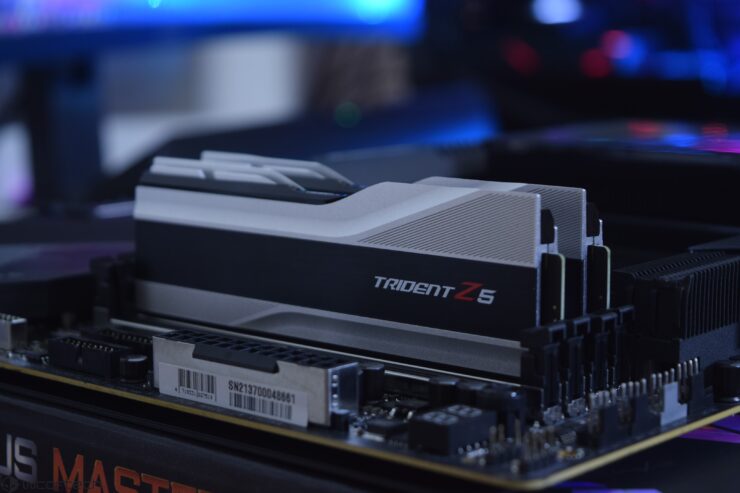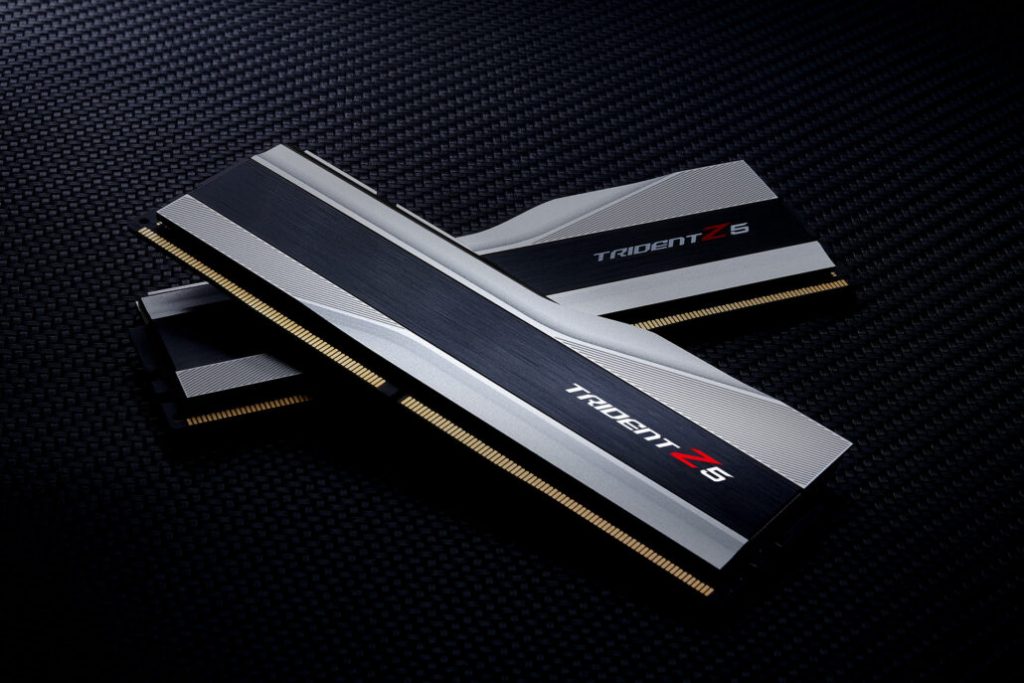
G.Skill is one of the top memory manufacturers known to gamers and enthusiasts in the PC industry. The company has been specializing in the memory industry for several years and their memory kits are very popular among the masses. There are memory lines from G.Skill that have been the eye-catcher since the company was formed, Trident and Ripjaws.
Both of these series have now become the choice of enthusiasts and overclockers as they come with an impressive specifications list and some of the best design schemes on the market. With the launch of the DDR5 standard, G.Skill is introducing its brand new Trident lineup, the Trident Z5, which comes in high-speed flavors with Samsung ICs and many options to choose from.
G.Skill Trident Z5 32 GB DDR5 Memory Kit Specifications
For this particular testing, G.Skill sent me its Trident Z5′ F5-6000U3636E-32TZ5S’ 32 GB (16 GB x 2) kit which comes with clock speeds of 6000 MT/s. The memory kit consists of dual 16 GB DIMMs which make up a total of 32 GB in capacity. Following are the full specifications of the kit I’ll be testing:
- Memory Type: DDR5
- Capacity: 32GB (16GBx2)
- Multi-Channel Kit: Dual Channel Kit
- Tested Speed: 6000 Mbps
- Tested Latency: 36-36-36-76
- Tested Voltage: 1.30V
- Registered/Unbuffered: Unbuffered
- Error Checking: Non-ECC (On-Die)
- SPD Speed: 4800 Mbps
- SPD Voltage: 1.10V
- Fan Included: No
- Warranty: Limited Lifetime
- Features: Intel XMP 3.0 (Extreme Memory Profile) Ready
- Additional Notes: Rated XMP frequency & stability depends on MB & CPU capability
The memory kit has a tested latency spec of CL36 and the timings are 36-36-36-76 for this specific kit. The voltage set at reference is 1.30V and the memory kit comes in an unbuffered package with a non-ECC (On-Die Error Correction) design.
The memory kit is fully compliant with Intel’s XMP 3.0 and can be easily set to its rated clock speeds through the BIOS shipped on the latest Intel motherboards. Memory compatibility differs from motherboard to motherboard so make sure that your board is high-end and rated to support high clock speed memory sticks.
G.Skill offers a limited lifetime warranty with their G.Skill Trident Z5 series memory kits. They are a bit bulky and the heatsinks extend from the top making it harder to install these with a dual-fan heatsink cooler. Make sure there’s enough space with an air cooler before installing these. The kit would go perfectly well with an AIO liquid cooling solution, leaving room for the RGB lighting showcase.
G.Skill Trident Z5 32 GB DDR5 Memory Kit Unboxing and Close Up
The G.Skill Trident Z5 series memory comes in a standard cardboard package. The box has the G.Skill Trident Z5 and DDR5 labels on the front and also tells you that it is both XMP 3.0 compliant.
We are looking at the F5-6000U3636E-32TZ5S SKU which features 32 GB of RAM capacity which is clocked in at 6000 MT/s at CL36 timing.
Within the package are two DDR5 DIMMs along with a G.Skill case sticker badge.
Outside the package, the G.Skill Trident Z5 series offers a very aggressive look that features a high-end heat-spreader. The design choice that G.Skill has gone with is very eye-catching and will look great even without the RGB LEDs. Do note that an RGB flavor is also available.
G.Skill provided us with their silver-colored Trident Z5 series memory. Do note that there are both silver and black-colored DIMMs available. The top of the heatsink is colored black and looks great with almost any PC build.
G.Skill experimented a lot with its diffuser system on the previous generation DDR4 Tridents. The new Tridents come in both RGB and Non-RGB flavors but even without the LEDs, their design looks very premium and the heat spreader and the multi-sided curve at the top really stand out from the rest of the DDR5 offerings.
The heat spreader makes use of a black brushed-aluminum strip inset into a metallic silver or matte black body and topped with a sleek black top bar.
The frame of the memory DIMMs is of a high-class design that uses polished aluminum heat spreaders of either black and silver color (silver in our case).
The memory modules are bulky and pack a solid heatsink that delivers optimal thermal performance. The sides feature a large Trident Z5 RGB logo. The DRAMs are fully covered by this aluminum shielded heatsink so higher temperatures won’t be an issue on these sticks.
Following is how the memory looks when installed on a Z690 motherboard. Do note that we will have an RGB kit with us soon so we can show you how that looks too soon!
Intel Z690 / Core i9-12900K DDR5 Memory Test Setup
For testing, I used the latest Intel Core i9 12900K processor along with the Z690 AORUS Master motherboard which can support higher frequencies memory without any issues. The XMP profile for each respective ram kit was enabled. That’s 6000 Mbps CL36 for the G.Skill & 6000 Mbps CL40 for the T-Force kit.
DDR5 Memory Test Platform:
| Processor | Intel Core i9-12900K @3.2 GHz (Stock) (DDR5 Memory) Intel Core i9-11900K @3.5 GHz (Stock) (DDR4 Memory) |
|---|---|
| Motherboard: | Gigabyte Z690 AORUS Master (DDR5) ASUS ROG Maximus XIII Extreme (DDR4) |
| Power Supply: | ASUS ROG THOR 1200W PSU |
| Solid State Drive: | Samsung SSD 980 PRO M.2 (1 TB) |
| Memory: | TeamGroup T-Force Delta RGB 32 GB (16 GB x 2) DDR5-6000 CL40 G.Skill Trident Z5 32 GB (16 GB x 2) DDR5-6000 CL36 G.Skill Trident Z Royal 16 GB (8 GB x 2) DDR4-4400 CL18 |
| Case: | Corsair Graphite Series 780T Full Tower |
| Video Cards: | MSI GeForce RTX 3090 SUPRIM X |
| Cooling Solutions: | Corsair H115i PRO |
| OS: | Windows 11 64-bit |
The memory kit comprises 2 DIMMs that operate in dual channel mode. Since we were running a Z690 platform, the memory was operating in dual channel mode.
Additionally, I managed to get an overclock of DDR4-6400 Mbps with the G.Skill Trident Z5 kit while retaining the CL36 (36-36-36-76) timings at 1.35V.
DDR5 Memory Kit Performance Tests With Intel Core i9-12900K
I have separated the performance tests into two sections. The first section consists of pure synthetic and general workload tests while the second section would be focusing on gaming performance and how different games are affected by higher clocked memory sticks.
AIDA64 Memory Bandwidth Benchmark
For AIDA64 memory tests, I ran the kits at both stock and overclocked speeds. The stock speed was configured at the XMP 3.0 profile of 6000 Mbps CL36 for the Trident Z5 memory kit.
SuperPI
Super PI is used by many overclockers to test the performance and stability of their computers. In the overclocking community, the standard program provides a benchmark for enthusiasts to compare “world record” pi calculation times and demonstrate their overclocking abilities. The program can also be used to test the stability of a certain overclock speed.
Winrar
WinRAR is a powerful archive manager. It can backup your data and reduce the size of email attachments, decompress RAR, ZIP, and other files downloaded from the Internet, and create new archives in RAR and ZIP file format.
Gaming Performance Tests
Gaming applications generally don’t see huge gains with different memory kits but DDR4 has enabled a huge gain in memory frequency which can impact gaming performance. Moving from the stock 3200 MHz to 3600 MHz and beyond 4000 MHz can have a slight effect on performance and the improved CAS timings on some of the high-end SKUs can result in better overall FPS and system responsiveness.
[/chart]
Furthermore, while 8 GB has become the standard for gaming PCs, modern applications such as editing software and multi-tasking users can benefit hugely from 16 GB and 32 GB kits which have become more common in the gaming market over the last couple of years.
Conclusion – Futuristic Design For A Futuristic Memory Standard
G.Skill’s Trident Z5 DDR5 series has received a nice upgrade over its Trident Z series predecessors based on the DDR4 standard. With DDR5, G.Skill has delivered higher performance & faster transfer speeds, that in return provide nice gains in applications and gaming. The memory also features enough headroom for overclocking. Even with its 1.35V stock XMP voltage, the DIMMs can be pushed to +400 Mbps with ease. The net return is minimal over the JEDEC 4800 Mbps speed but you can tinker around and get even better overclocks. G.Skill is also aiming for new heights and has already teased 7000 Mbps DIMMs that are currently in development.
The main hurdle in the way is the higher CAS latency due to the CL36 timings which still isn’t close to what DDR4 was able to offer. While the raw bandwidth speeds have gone drastically up, there is a small number of applications that still depend upon tighter timings, especially the 0.1 & 0.01% low in games that can see a slight improvement. G.Skill has done their best to verify their Trident Z5 series on almost all Z690 motherboards which work in their favor for long-term compatibility.
As for pricing, well we were told that these specific modules are very short in supply and currently, there’s no set price but they are expected to range somewhere around $400-$500 US or higher. In talks with G.Skill, we were told that the company doesn’t face PMIC shortages as much as other vendors as they were able to acquire enough for their Trident Z5 production. This means that the Trident Z5 series might not be as short in supply as some of the more prominent names in the DIMM market.
The design for the Trident Z5 series is also futuristic and the theme reminds me of the Normandy SR2 from Mass Effect. It definitely looks great in silver and users have the option to get them in black colors too, with or without RGB. The aluminum heat spreader has been forged to deliver great looks and also great cooling. G.Skill’s Trident Z5 series is definitely a rocker in terms of looks and performance but with limited availability, you might have to wait a while to get hands on these fantastic DDR5 DIMMs.
The post G.Skill Trident Z5 DDR5 32 GB (2 x 16 GB) 6000 MHz CL36 Memory Kit Review – Now That’s Fast! by Hassan Mujtaba appeared first on Wccftech.
